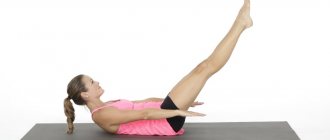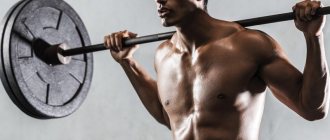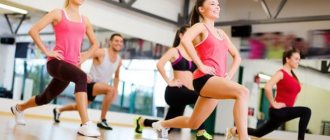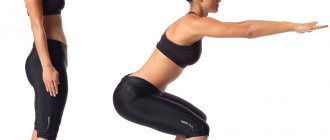What are isometric exercises
Isometric exercises are the basis of strength training. The term “isometrics” can be translated from Greek, which can be interpreted as “constant distance.” During isometric exercises, the athlete’s physical efforts are aimed at forceful tension, while the muscles do not change their length and the joints do not change their bend angle.
When performing a task, due to the fact that the muscles do not have the usual dynamic contraction, the main load falls on the tendons. The process leads to a gradual increase in physical strength, as well as an increase in the body's ability to create increased forces in a short period of time.
Different phrases are used to refer to isometric exercises:
- gymnastics of Samson, Zass;
- tendon gymnastics;
- statics;
- static exercises;
- isometry.
Isometric exercises are the opposite of dynamic exercises.
Isometric exercises differ from dynamic training:
| Isometrics | Dynamics |
| Develop maximum strength values | Helps develop breakthrough capabilities |
| Strength development for static poses | Development of strength through range of motion |
| Helps strengthen tendons | Activate muscle building |
There are several benefits of isometric exercises in terms of time involved. Experts characterize isometric training as a means of achieving goals in a short time.
Regular workouts take a long time, requiring rest between main approaches to recuperate. Isometrics has the main advantage: the period of time devoted to statics fully engages the muscles throughout the entire period of working time.
In addition, the advantages of isometric strength training are highlighted:
- Availability . Special rooms are not chosen for isometric exercises. You need a room where there is enough space to stretch the body, and basic things such as towels, belts or harnesses, and support are also available.
- Opportunity to train daily . Long breaks are not required to restore strength after isometric exercises. Classes are held regularly, daily, several times a day.
- The ability to increase strength in a short time with the right approach to performing exercises.
Among the disadvantages of isometric exercises, several points are highlighted:
- It is not recommended to start practicing isometrics on your own. At the initial stage, it is necessary to be accompanied by a trainer.
- When performing exercises, pay special attention to proper breathing.
- To achieve maximum results, isometrics are always accompanied by dynamics.
- Isometric exercises are not aimed at improving coordination abilities.
- Long-term isometric exercises help shorten muscles.
Exercises are not performed if there are contraindications. Fixing isometric poses and training tendon muscles significantly increases blood pressure.
Therefore, isometry is contraindicated:
- for hypertension;
- with hypotension;
- the presence of diseases associated with disruption of the structure of cerebral vessels, blood flow, and heart problems.
Features of Bruce Lee's training
Technique is important in any sport. Bruce Lee also paid attention to her.
- The training methodology from the famous athlete is not aimed at increasing muscle mass, but at improving endurance and strength parameters. However, this is noticeable in Bruce Lee himself.
- The training technique is based on absolute dedication to the process of free time and effort. Only through hard work can you achieve results and become a real example to follow. Training at half strength will never bring a positive effect, and can even cause serious injuries.
- The main emphasis in the program is on working out the abdominal area, running and isometric work. Of course, we couldn’t do without classic, basic bodybuilding exercises.
- Bruce Lee considered the abdominal muscles to be the most important part of the body. Only if you have a powerful, strong, carefully pumped corset can you withstand serious loads.
- Bruce Lee experimented constantly. He always tried new techniques and methods, successfully applying them during training. As a result of such work at the limit using an isometric load, his muscles began to be called “marble.”
Interesting fact. The famous athlete has never used weight training equipment. His main working equipment is dumbbells, kettlebells and a barbell (in rare cases).
How to do exercises correctly and safety
Strength training, built on the basics of isometrics, has characteristic features. When conducting classes, special attention is paid to safety precautions. Forceful loading of muscles and tendons when performed incorrectly can cause painful injuries.
Before you start training, experts recommend studying the basic safety rules:
- perform from 10 to 20 exercises daily, no more;
- when fixing the pose, do not hold your breath, tense your muscles only when you inhale;
- when performing an exercise, certain muscles are tensed throughout the body;
- certain types of exercises last no more than 6 seconds, with a minimum break of 30 seconds between them;
- the increase and decrease in the load on the muscles occurs smoothly, without jerking;
- If headaches or severe pain in the joints and tendons occur, stop exercising.
Training complex for various parts of the body
The above examples are mainly suitable for the muscles and tendons of the arms. We will describe below a set of isometric exercises for other parts of the body and give a few more examples that can be performed at home or in the office, without any special sports equipment.
To strengthen the buttocks and legs
- While sitting at a table, cross your legs. Use your upper knee to push the table upward.
- Standing on one leg, bend the other at the knee and hold your foot with your hand. Press your foot down as hard as you can.
- Sitting on a chair, straighten your legs, place them one on top of the other and lift them up. Press your lower leg up and your upper leg down.
To strengthen the press
- Sitting on a chair, clasp your hands behind its back. Try to lean forward like this.
- Lying on your back, place your hands on the floor. Raise your outstretched legs and hold for 6-12 seconds. Then lower your legs and raise your back to 45 degrees and hold in this position.
For the back
- While sitting on a chair, bend over and squeeze the legs of the chair with your hands. Try to pull them up.
- Sitting on a chair, tuck your legs and clasp your hands around your hips. Without bending your arms, try to lift your shoulders up.
For the chest
- Sit down and clasp your bent arms in your palms at chest level. Squeeze them vigorously for 6-12 seconds.
- With your arms extended in front of you, clasp your hands together. Try to break this lock.
- Clench one palm into a fist, and with the other palm press firmly on the fist, extending your arms at chest level.
For neck muscles
- Place your hands behind your neck and clasp them there. With maximum effort, try to pull your neck forward, while your neck should resist the pressure on it.
- Sitting on a chair, throw your head back and rest your elbows on the table. Place your chin in your palms and try to lower your head.
- Do the same, only rest your forehead on your palms instead of your chin.
Well, we looked at many different trainings. We hope that this information was useful to you and these classes will be a good help for you in developing the strength of your muscles and tendons. Good luck in the gym and beyond!
Necessary equipment
To perform isometric exercises, you need support, which can be walls, chairs, or window sills. For stretching, use belts, ropes or towels.
Immediately before training, it is recommended to perform a set of exercises that help stretch the muscles. This helps warm up and prepares the muscles for further work.
Don't miss the most popular article in the section: Body drying for girls. Training program, detailed nutrition menu for the month by day.
Advantages and disadvantages
The popularity of isometric training is gradually returning again, due to the large number of positive aspects of such practices.
Their main advantages are given below:
- Saving time , which is facilitated by performing isometric exercises. Daily workouts do not last long, and long preparation is not required to transfer the muscles into working mode.
- No feeling of fatigue , after which a long rest is required both for the person doing the exercise and for his muscles separately. This helps to increase the frequency of training and achieve the desired result more quickly.
- No need to purchase additional equipment.
- The ability to direct all your strength to the development of certain parts of the body or muscle groups that need it most.
- Simplicity of the technique , many exercises can be done even in public places, which will remain unnoticed by the people around you.
- High degree of efficiency and guaranteed results.
- The ability to be performed even by people without training or in poor physical shape, while the likelihood of injury or any damage is minimized.
The only drawback is mastering the correct technique: it is not difficult, but is learned over time. If the basic rules are grossly violated, a side effect is possible, which manifests itself in the form of surges in blood pressure.
Methodology of Alexander Zass
Alexander Zass was the founder of static exercises in the 20th century. on Russian territory. The complex developed with its help is based on yoga exercises, as well as techniques of Chinese martial art. Alexander Zass was called Samson or Iron Samson, he was awarded the title “The Strongest Man on Earth.”
Moreover, his body weight was only 75 kg, but in the circus arena where he worked, he could lift 2 adult lions on a special yoke.
Zass attached great importance to isometric exercises in his own training; he believed that isometrics can save not only time, but also energy. Alexander Zass's method is based on training with chains or belts. In this way, Samson increased his own capabilities, which he later demonstrated in the circus arena.
Bruce Lee Method
Sports experts believe that for his daily training, Bruce Lee took isometric exercises based on the method of Alexander Zass. In addition, he used the basic rules of bodybuilding. As a result, the Bruce Lee system was developed; it includes isometric exercises that are accessible even to inexperienced athletes.
Bruce Lee performed one exercise from the list every day, supplementing it with other training according to his own method, while he believed that when performing static exercises it is necessary to follow several basic rules.
For example:
- he did early morning workouts;
- thoroughly ventilate the room before training;
- After gymnastics, I considered it mandatory to take a contrast shower.
Exercises with the crossbar:
- Stand up straight, extend your arms shoulder-width apart.
- The crossbar is installed a few cm below outstretched arms, and the crossbar is grasped.
- Then they press on it with maximum force for about 6 - 10 seconds.
Lifting on your toes:
- The crossbar is placed above the shoulders, then smoothly raised on the toes.
- In this case, the shoulders create pressure with maximum force on the crossbar for 6 - 12 seconds.
Squat:
- Install the crossbar at such a level that you can rest your shoulders on it in a squat position.
- Squat down and apply pressure to the bar for 6 - 10 seconds.
Types of isometric exercises and methods of performing them
Once you have defined and understood exactly how it works, as well as what benefits it can bring, it remains to figure out how to practice it. The main ones are the deadlift, bench press, and squat. Just by doing them you can achieve significant results. But usually they also add shoulder lifts and toe lifts. All isometric exercises can be divided into three main subgroups.
- Isometric-static. They are aimed at developing muscle tension in its purest form. For example, when you resist an effort that cannot be overcome.
- With weights. In this case, movements are performed with periodic stops. It is precisely during moments of immobilization that the very necessary muscle tension is created.
- With the maximum possible burden. This is a kind of combination of isometric-dynamic movements, in which they stop at the most effective phase of the movement, and the position is fixed.
With the help of such loads, you can achieve the desired effect of static muscle tension. Usually, in this way, experienced athletes pump up muscles that normally remain unused and therefore seriously lag behind in development. For such classes, a simulator was specially developed - a frame with a fixed tube. However, you can do without it by using an arbitrary object that has a rigid fastening.
Bob Hoffman's set of exercises
At the beginning of the last century, a famous trainer wrote a book called “One Minute Every Day for Endurance, Strength and Health.” In it, he collected exactly twelve static exercises that do not require additional equipment. It is recommended to use a regular door frame as a static object here. Alternatively, you can simply lean on the wall. It only takes 1-2 minutes for the exercise to be considered completed.
- Stand facing the door, keep your head straight, back straight. The arms are slightly bent at the elbows, resting on the top bar. Press your palms against the door frame for the required amount of time.
- Squat down slightly without removing your hands from the top bar. Now the force should be directed upward, not forward, while keeping your arms straight.
- Rise up on your toes, as high as possible. Hold the position for six seconds. Return to the starting position.
- Stand with your back to the wall, resting the back of your head against it, place your hands on your waist, feet shoulder-width apart. Do not throw your head back; for convenience, you can place a folded towel. Press the back of your head against the wall as long as possible.
- Turn your face to the wall, placing something soft under your forehead. Repeat the pressure in this position. It is important not to bend your back or twist your neck.
- Bring your hands together in front of your chest. You can clasp your fingers for convenience. Press one palm onto the other with maximum effort.
- Repeat the same thing, only connecting your hands only at the fingers.
- Stand facing the doorway, rest your palms on the side slats or trim, if any. Press down firmly on the jamb and secure the position.
- Repeat the first exercise, but perform it alternately with your right and left hands.
- Secure any object to the frame, and then pull it down with both hands.
- Sit on the floor, rest your feet on the vertical parts of the doorframe. When changing the angle, press with force.
There is no need to overwork too much. 5-6 seconds are enough to feel the tension and also get the effect of the exercise. This complex can be safely used either separately or together with strength or cardio training. Many bodybuilders and bodybuilders use it as an additional leisure activity.
Samson's isometric exercise system
Another name for such a complex is the method of the wrestler and athlete Alexander Zass, who bore the nickname Iron Samson. He believed that strength lies not in muscles, but in tendons, and he was right in many ways. Therefore, he easily defeated opponents in the ring, tied flirty bows from iron reinforcement and bent horseshoes and nails like cotton wool. His original system of isometric exercises involves the use of special chains with hooks and handles at the ends.
- Place your feet wider than your shoulders, shift your weight to your left leg, and straighten your arm on the same side along your body, holding one end of the chain in it. With your right half-bent hand, pull the other end of the chain. Change position, repeat the same on the other side.
- Grab the ends of the chain so that they are shoulder-width apart or even slightly wider. Raise them above your head. You need to pull with equal force in different directions so that not only the arm muscles work, but also the sternum, and at the same time the latissimus dorsi muscles.
- Stretch the chain in front of your chest, while pulling in different directions, that is, your arms should cross.
- * Pass the chain behind your back, just in the area of your shoulder blades. Pull it with half-bent arms to mainly tense your triceps. The muscles of the chest and abdominals are worked out at the same time.
- Wrap the chain around your chest. Standing straight, without bending, try to break your improvised shackles.
- Attach the chains with loops to your feet, or the easiest way is to stand on the chain, stretching it under your feet, straight posture, arms extended along the body. Pull the chain up, contracting your arms and trapezius.
- Take the chain “diagonally”, that is, raise one hand and lower the other. Stretch it for the required time, and then change the location of the limbs, repeat the exercise again.
- With one foot slightly forward, hook the chain on your foot or simply step on it, leaning with your whole weight. Pull the equipment up with your hand bent at the elbow, your palm should also “look” up.
- Squat down slightly with your legs bent and knees wide apart. Stretch the chain on the thigh first of one and then of the other leg.
- Fasten one end of the chain to your neck, and step on the other with your foot. Pull as hard as you can. Switch legs and repeat the exercise.
- Do a lying position, stretching the chain across your neck and holding its ends with your hands. Try to stretch it up as much as possible.
- Secure the chain with a loop on your foot, bend your leg at the knee, stretch it upward with your hand, trying to push down with your foot.
You can come up with a lot of variations of such exercises yourself. The legendary athlete himself, who calmly carried a horse on his shoulders, said that you can arrange them according to your own understanding, depending on what muscles you need to pump up.
Bruce Lee isometric exercises
The famous martial artist, despite the longevity of his career, managed to use many different techniques and trainings. He used not only kung fu, but also static exercises. Anyone can repeat them. This complex will require a frame with a crossbar that you cannot move or lift. It could be just a bar in a doorway, or it could be a barbell in a machine with excessive weight.
- Stand straight with the bar just below your arms outstretched. Push your hands and create maximum tension without rounding your back or bending your knees.
- Lower the bar to chin level. Press on it from below with bent arms, grabbing it with a direct grip.
- Set the bar just above shoulder level, stand under it, you can rest your hands on it, and then press on it with your shoulders, rising on your toes.
- Place the bar below waist level, approximately at hip level. Grab it with your hands and pull it up.
- The bar should be placed at such a level that in a horizontal squat it is just at shoulder level. Press on it from below, you can help yourself with your hands.
- The bar or barbell should be set at a level slightly below the knees, as for a regular deadlift. Pull it up for the right amount of time.
- Squat into a quarter squat, leaning on a bar placed at a height appropriate for your shoulders.
All these exercises should be done with the thought that you will cope with the task and lift the imaginary barbell off the ground. Bruce Lee himself did the “Frog” after such exercises, which can be recommended to everyone. Hang on the horizontal bar with all your weight, and then pull your legs up a dozen or two times, depending on your initial physical fitness.
Isometric “Volitional gymnastics” by A. K. Anokhin: a set of exercises
The Kiev doctor, an active promoter of sports and a healthy lifestyle, himself an athlete, created his own set of exercises, which was also used by the famous strongman Iron Samson Zass, as well as commander Kotovsky. Always inhale through your nose and exhale through your mouth, Alexander Konstantinovich considered this an important factor.
- Basic stance: back straight, feet shoulder-width apart. Raise your arms to the sides, clench your palms into fists, and turn the insides towards you. As you inhale, begin with an effort, as if a large weight is opposing you, to pull them towards your shoulders. After touching the skin, as you exhale, open your fists and perform the opposite movement. Work the biceps first, then the triceps.
- In the same position, raise your arms in front of you and up. As you inhale, begin to slowly bring your hands together, as if you are squeezing something, and as you exhale, again spread them up and to the sides.
- Lie on your back on a horizontal hard surface, place your hands behind your head. For convenience, you can lock them together. Without moving your torso, use only the muscles of your thighs, buttocks and abs to lift your leg, and then lower it again. Repeat with the other leg.
- Stand facing the back of a chair, place your hands on it. Place your heels together and point your toes out to the sides. Perform the squat very slowly until your buttocks touch your heels. Also slowly stand up while exhaling.
- From the same starting position, holding the back of the chair, slowly rise onto your toes, and then lower back down.
- Also standing near a chair, bring your heels together. As you inhale, lift your toes, trying to pull them as high as possible, and as you exhale, lower them to the surface.
- Place your feet shoulder-width apart, feet turned outward. Raise your arms to the sides, fists clenched, turned upward with the inside. Slowly raise your arms, inhale, then lower, then exhale.
- Alternately bend and straighten your elbows, being in the same position as if you were pumping your biceps with dumbbells.
- Raise one hand up and the other to your shoulder. Slowly and forcefully change the position of your hands.
- Raise your arms to the sides in the same position. Slowly lower and raise your hands, do not unclench your fists.
- Perform push-ups while lying down, while trying to place the main load on the triceps.
- Turn onto your back, cross your arms over your chest, spread your legs shoulder-width apart, and place your heels on the floor. Raise yourself slightly, using your abdominal and back muscles, and lower to the starting position.
Keep in mind that Anokhin’s version of the exercises must contain a certain amount of artistry. After all, we will have to work with an imaginary weight that does not actually exist. Just imagine heavy weights that you lower and lift, then it will be easier to determine the load.
Anokhin's volitional gymnastics
By the beginning of the 20th century. The system of physical exercises of the Russian athlete, Dr. Anokhin, which was called volitional gymnastics, became popular. No special equipment or space is required to perform these exercises. Anokhin's volitional gymnastics is often called indoor gymnastics.
When compiling the methodology, the doctor was guided by the principle that it is impossible to invent new movements for the body, you can only vary the principles of their execution. The lack of weights (dumbbells or weights) was not an obstacle to straining the corresponding muscles.
Anokhin formulated 8 principles for those wishing to familiarize themselves with the methodology:
- all attention should be focused on the muscle or muscle group being trained;
- increasing the load, mastering a new exercise should be slow;
- When performing the exercise, it is necessary to monitor the breathing order;
- the exercise must be performed in front of a mirror;
- After training, you need a contrast shower and thorough rubbing of the body with a rough towel.
In addition, Anokhin recommended adhering to a restrictive diet. Food, in his opinion, should be varied, but simple.
Basic exercise:
- The arms are spread to the sides, the fist is clenched, the palms are turned upward, straining the biceps.
- Bend your arms at the elbows, while simulating pulling a large load.
- Then they begin to straighten their arms as if they want to push away the load.
- When bending your arms, inhale, when extending, exhale.
Extra traction:
- Set your feet shoulder-width apart, raise your arms forward, and clench your fist. At the same time, the back muscles are strained.
- They spread their arms, then begin to bring them together, as if squeezing a large box at chest level.
- When raising your arms, inhale, when bringing your arms together, exhale.
Lying position:
- They lie on their back, keep their body completely still, but at the same time quickly raise and lower their legs.
- The elevation angle should be 50.
Static exercises to develop arm strength
For triceps:
- Take the belt in your hands and extend them in front of you
- Stretch the belt in different directions until you feel very strong tension in the triceps muscle of the shoulder
- Place your hands opposite your stomach and pull them in opposite directions
- You can stretch your arms parallel to your body or raise them above your head
Isometric gymnastics for biceps:
- Take an expander or jump rope and press one end firmly with your foot to the floor
- Take the opposite end of the sports equipment in your hand extended in front of your chest
- Pull the expander/rope while keeping your arm bent at the elbow at a right angle
- After a few minutes, carefully release the load and change hands
Isometric gymnastics Borshchenko
Dr. Borshchenko created a special complex of isometric gymnastics, the purpose of which is to combat back diseases, characterized by muscle dystrophy and degeneration. The technique is used to treat the spine and musculoskeletal system. Borshchenko's techniques focus on the lumbar spine.
The advantage of the system is security and accessibility. Gymnastics is suitable for people of different abilities and ages. Gymnastics is effective as a preventive measure or a concomitant comprehensive measure in the treatment of back diseases. Its goal is to increase the endurance of the back muscle corset.
When performing Borshchenko gymnastics, it is recommended to adhere to the basic recommendations:
- the order of performing the exercises does not matter;
- Stretching is required before classes;
- To perform the exercises correctly and increase efficiency, it is important to follow the system; training must be regular.
Despite the fact that gymnastics is accessible to most people of varying degrees of physical fitness and different ages, you should consult with your doctor before starting it.
Isometric exercises[edit | edit code]
The essence of isometric exercises
lies in the fact that within 6-12 seconds maximum effort is expended to counteract the resistance of a particular object. This is what distinguishes isometric exercises, in which muscle contraction only causes tension, from isotonic exercises, during which muscle contraction causes its length to change. One of the most popular isometric abdominal exercises is the plank.
Benefits[edit | edit code]
Firstly, this is a huge time saving. These exercises only take a few minutes to engage your muscles.
Secondly, in such a short time the muscles do not have time to get tired to the same extent as during a regular workout (lasting 1-2 hours), after which 24-36 hours are needed for the muscles to fully rest, and without sufficient rest, as has already been said many times, Neither muscle strength nor their mass increases.
Since the time required for rest decreases when performing isometric exercises, you can train much more often.
And finally, one of the biggest advantages of isometric exercises is that with their help it is very convenient to develop and strengthen exactly those muscles that especially need it at the moment.
When performing traditional isotonic-dynamic exercises, maximum muscle tension lasts only a few seconds, that is, in the sum of all exercises done (over 1-2 hours), no more than 2-6 minutes per workout. Isometric exercises can perform the same task in just a few minutes a day. Moreover, the increase in muscle strength in this case is not inferior to the increase in strength during isotonic exercises.
When performing isometric exercises, the blood vessels that supply oxygen to the muscles contract. The cells are forced to work more intensely and do not expend as much energy as during isotonic muscle movement (in which most of the energy is spent on the movement itself). Thus, all muscle energy when performing isometric exercises is spent only on tension, and not on movement. Therefore, muscle development occurs in a much shorter time.
How to build an isometric workout
Isometric exercises are built in accordance with basic rules and compliance with safety precautions.
Attention is paid not only to the choice of training session, but also to related factors:
- The training is carried out in the morning, when the muscles begin to awaken after a night's rest.
- Before starting static exercises, do some stretching. Consistently stretch the muscles of the back, legs, and arms.
- To conduct classes, select a muscle group to work.
- When fixing poses, take into account the maximum and minimum duration of the exercise.
- Take a break between exercises.
After training, a contrast shower is a good way to relax your muscles. After training, it is recommended to follow a diet and replenish the fluid balance in the body.
People with varying levels of fitness can use isometric exercises. For those involved in bodybuilding, static poses with muscle tension are a way to increase strength. For non-professional athletes, isometrics can be a way to strengthen different muscle groups and improve body contour.
Article design: Oleg Lozinsky











